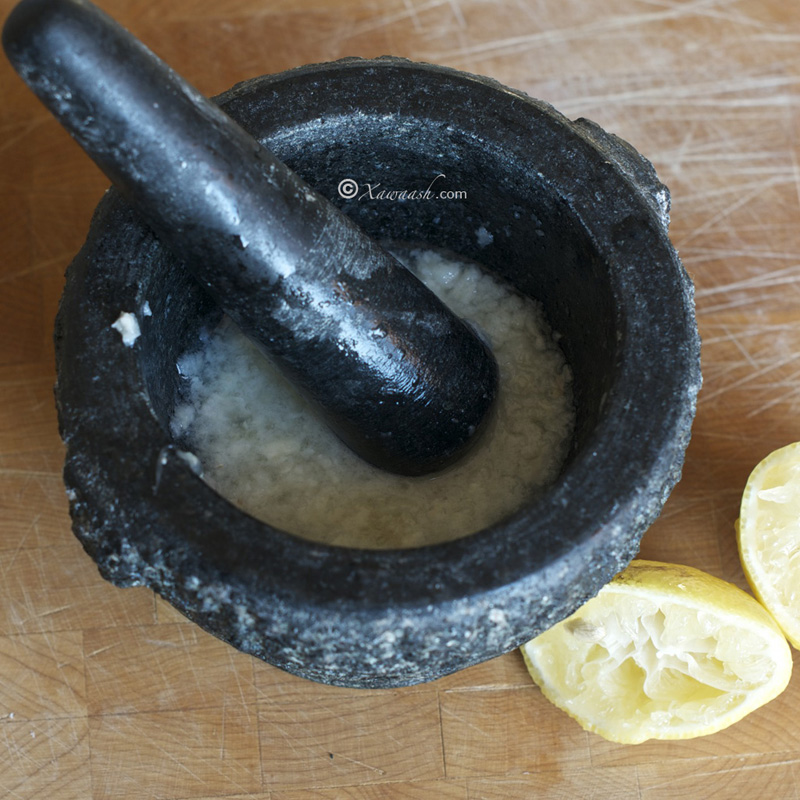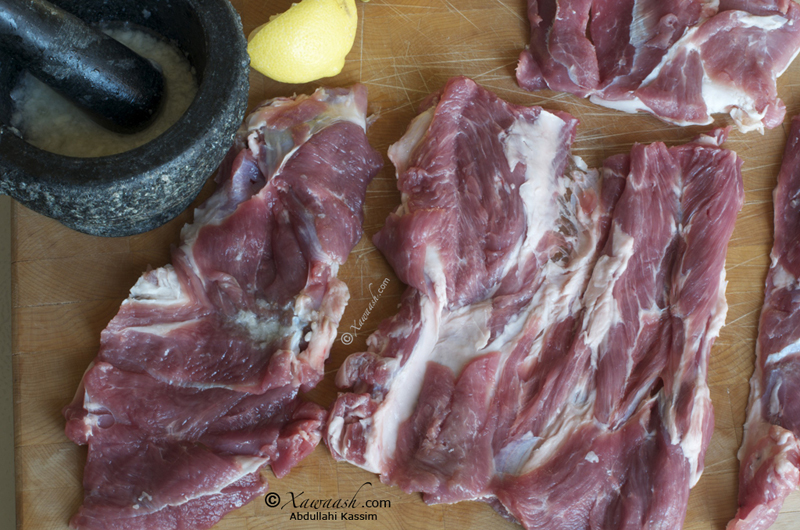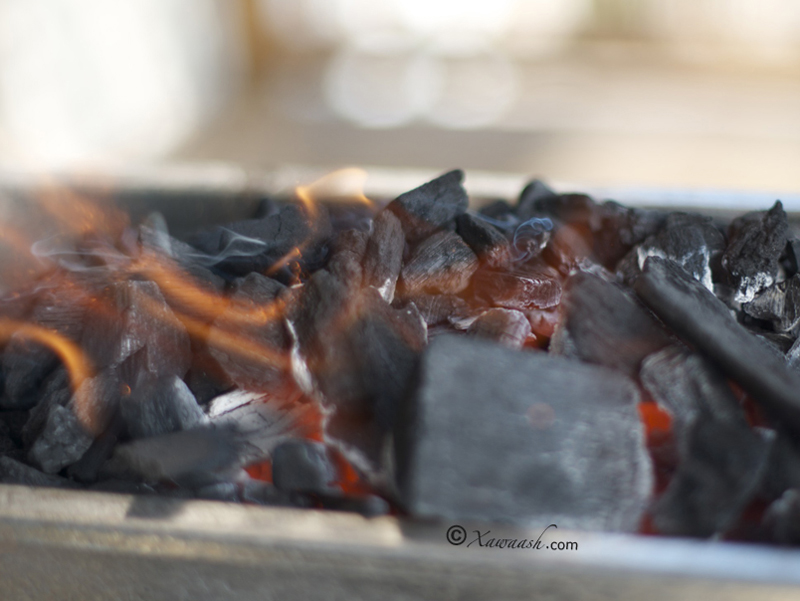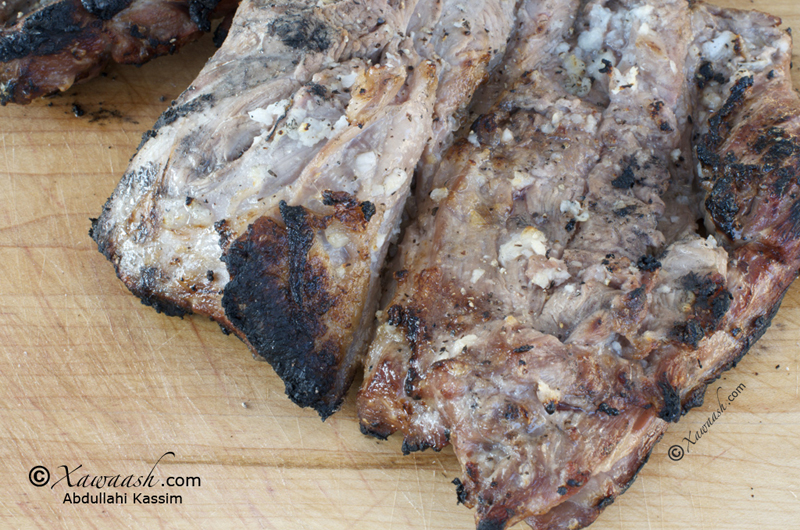
If there is a food that represents Somalia, it is Cad iyo Caano. It is the closest thing to a national dish. Cad iyo Caano is Somali for “A Chunk of Meat and Camel Milk,” or simply “Meat and Milk.” You can argue that some regions of Somalia have their own representative dishes, but the term Cad iyo Caano has come to represent more than just meat and milk. Having Cad iyo Caano means having prosperity and sustenance.
This post is about the meat-and-milk Cad iyo Caano. It’s about lamb cooked directly on hot coals, a common way of cooking meat in Somalia. Meat cooked this way has a unique flavour that can’t be replicated by any other cooking method. Apart from the wonderful smoky flavour that you get, a charcoal fire can reach temperatures well above 1000°C (1832°F). When you place meat directly on super hot coals, it is seared quickly and it makes the meat moist and tender.
The most common mistake when cooking directly on coals is to place the coals on a grate. This results in flare-ups when the fat drips down and hits the bottom of the grill. Flare-ups deposit soot on the meat which gives it an unpleasant taste. Charring, on the other hand, imparts a nice flavour.
Somalis know their meat and they always go for those parts that are closest to the bones: ribs, shoulders, and shanks. These are more tender and flavourful and the pecking order determined who got them.
Unlike a lamb leg, when you debone a shoulder, you won’t get one contiguous piece of meat. Our butcher gave us two large pieces which we cut into even smaller pieces to make them easier to handle on the barbecue. The meat was about an inch thick on average but it wasn’t evenly thick. This was an advantage because in our family, not all of us agree on the right doneness of meat. Some of us prefer the meat to be well done, while others prefer it to be medium or medium-rare.
Somalis don’t have a penchant for rare meat, and it’s only in the diaspora that some have acquired a taste for meat that is medium or medium-rare. Both of us order our steaks to be cooked medium-well, but when it comes to lamb, we have discovered that it is a meat that is enjoyed best when it is at medium doneness.
Deboning the meat made it possible for the meat to be cooked quickly. We cooked it 3 minutes on each side, and if you prefer to have it well-done, cook it 4 minutes on each side. That is still a cooking time of just 8 minutes, which is more than the 10 minutes that we let the meat rest.
By deboning the meat we also got another bonus. We took home the bones and made a delicious lamb soup. Stay tuned for a post on “Lamb Soup for the Soul.”
Si il y a un plat qui représente la Somalie, c’est Cad iyo Caano. Il est ce qu’il y a de plus proche du plat national. En Somali, Cad iyo Caano veut dire “Un Morceau de Viande et du Lait de Chameau”, ou plus simplement “Viande et Lait”. On peut débattre des plats représentatifs de chaque région de Somalie, mais le terme Cad iyo Caano a évolué et veut dire plus que viande et lait. Avoir Cad iyo Caano veut dire avoir la prospérité et la pitance.
Ce post parle de l’aspect viande et lait de Cad iyo Caano. C’est de l’agneau cuit directement sur des braises, un moyen courant de cuire la viande en Somalie. La viande cuite de cette façon a une saveur unique qui ne peut pas être recréée avec une autre méthode de cuisson. En plus du merveilleux arôme fumé que vous obtenez, un feu de charbon peut atteindre des températures de plus 1000°C (1832°F). Quand vous placez la viande directement sur des charbons ardents, elle est rapidement saisie et elle reste juteuse et tendre. L’erreur la plus fréquente quand on cuit directement sur des braises est de placer les morceaux de charbon sur une grille. Cela crée des flammes quand le gras coule et tombe sur la grille. Les flammes déposent de la suie sur la viande qui lui donne un goût désagréable. La grillade, au contraire, lui donne bon goût.
Les Somalis sont des connaisseurs de viandes et ils choisissent toujours les morceaux le plus près des os: côtes, épaules, et jarrets. Ce sont les morceaux les
plus tendres et savoureux et l’ordre pour servir à table déterminait ceux qui en avaient.
A la différence d’une cuisse d’agneau, quand vous désossez une épaule, vous n’obtenez pas un seul morceau de viande continu. Notre boucher nous a donné deux gros morceaux que nous avons découpés en plus petits morceaux pour les rendre plus facile à manipuler sur le barbecue. La viande était d’environ un pouce d’épaisseur mais l’épaisseur n’était pas régulière. C’était un avantage pour notre famille, nous ne sommes pas tous du même avis sur le bon degré de cuisson de la viande. Certains d’entre nous préfèrent que la viande soit bien cuite, tandis que d’autres la préfère à point ou encore un peu rosée.
Les Somalis n’apprécient pas la viande saignante, et c’est uniquement la diaspora qui a développé un goût pour la viande rosée. Nous choisissons tous les deux des steaks bien cuits dehors encore rosés au milieu, mais pour l’agneau nous avons découvert que c’est une viande qui est la meilleure lorsqu’elle est saignante.
Désosser la viande permet de la cuire rapidement. Nous l’avons cuite 3 minutes de chaque côté, et si vous préférez la manger bien cuite, cuisez la 4 minutes de chaque côté. Ce qui fait un temps de cuisson de 8 minutes, ce qui est toujours moins que les 10 minutes où nous
laissons reposer la viande.
En faisant désosser la viande nous avons eu un bonus. Nous avons rapporté les os à la maison et nous avons fait une délicieuse soupe à l’agneau. Ne manquez pas notre prochain post: “la Soupe d’Agneau pour l’âme”.
Ingredients:
2.5 lb. Boneless lamb shoulder
5 Garlic cloves (minced)
2 Lemons
2 tsp Kosher salt
1 tsp Black pepper
Ingrédients:
2.5 livres d’Épaule d’Agneau désossée
5 Gousses d’Ail (hachées)
2 Citrons
2 cc de Gros Sel
1 cc de Poivre Noir
Directions:
Put the garlic and the coarse salt in a mortar. The salt will help in crushing the garlic. Add the lemon juice to the garlic paste. Marinate the lamb pieces on both sides. Let the lamb marinate while you get the fire going.
When the fire is ready, blow away the top layer of ashes. Place the lamb pieces directly on the hot coals. Cook for three minutes on each side for medium-rare to medium. Increase the cooking time to four minutes on each side for medium-well to well-done.
Let the meat rest for 10 minutes before cutting and serving. This way you won’t lose the meat juices and the meat will stay moist.
Instructions:
Mettre l’ail et le gros sel dans un mortier. Le sel aidera à écraser l’ail. Ajouter le jus de citron à la pâte d’ail. Étaler la marinade sur chaque côté des morceaux d’agneau. Laisser l’agneau mariner pendant que vous préparez le feu.
Quand le feu est prêt, souffler la couche de cendres. Placer les morceaux d’agneau directement sur les braises. Cuire pendant 3 minutes de chaque côté pour une cuisson saignante à rosée. Allonger le temps de cuisson à quatre minutes de chaque côté pour une viande cuite encore un peu rosée ou cuite à point.
Laisser reposer la viande pendant 10 minutes avant de la couper et de la servir. Cela permet de ne pas perdre le jus de la viande et qu’elle reste moelleuse.









I love charcoal-grilled meat and my reason for this is one you may share possibly. charcoal-grilled meat has much more flavor than Gas-grilled meat and I love the smoky flavor. This recipe has only five ingredients which makes cooking easier and faster.
Thanks for sharing such a delicious & nutritious dish! Your introduction was amazing too!
I’ve heard that eating alot of charcoal grilled meat cause health problems. Have you ever came across such kind of claim Abdullahi?
I certainly appreciate the job you are doing. Keep up the good work bro..!!
Thank you, Abdurahman, for your comment. With regard to the hazards of charcoal grilling, I would like to remind you that for thousands of years this was the only way of cooking meat. It stood the test of time. The risk is one in a million. If you are still concerned, there have been some recent studies that showed that this risk can be reduced by up to 88% if you use an acidic marinade. That is why we decided to add lemon juice to the marinade. Lemon juice also has a tenderizing effect on the meat.
ASC, waxaan halkan idinkaga soo dirayaa salaan somalinimo iyo islamnimo.
i’m loving your blog guyz.i’ll spread the word for sure.you’re making us proud.this is more than food and views.This is a somali pride…
love u guys
Wacalaykum Assalaam Ahmed! Thank you very much for your comment. We do love our beautiful Somalia!
ASC, Thanks to your blogs and videos I have a couple more dishes under my belt. I am forever thankful for your teachings of our recipes….especially to our younger generation so that we may carry over and teach these recipes to our children. I believe that the strength of culture is; aside many things, the food that brings our families together. If I may though and I mean not to offend or insult by any measurement..with all due respect….though all you are doing is wonderful…can you please please remove the music from your videos…seeing as to how Islam does not allow music and songs??. Even though I mute the videos I would still like for you to receive all the blessings under the sun and moon for the wonderful things you all are doing for us who by war and/or replacement or simple misinformation have not been able to learn our cultural dishes. May Allah bless you and your families near and far…duniya and akriah. May you find all the happiness both here and the hereafter. Ameen
Thank you.
Wa-alaikum assalam warahmatullahi wabarakatuh,
Thank you very much for taking the time to comment and letting us know how much you have benefited from the recipes and videos. We also thank you for your prayers and kind words. We are not the least offended by your letting us know about your reservations regarding the music in the videos. We are absolutely certain that it was said with the best of intentions. May God Almighty reward you for that. Aamiin.
We believe that in Islam, the prohibition of anything should be based on the Qur’an and the authentic Hadith. Except for matters of worship, everything is permissible unless there is proof for its prohibition. There is nothing in the Qur’an that says music is not allowed. Many Muslim scholars have said that the “idle talk” in Verse 31:6 cannot be applied to music and singing. There is disagreement on its interpretation and thus it cannot be used as proof for the prohibition of music. The proof has to be both clear and categorical. Therefore there is absolutely no proof from the Qur’an.
Sheikh Yusuf al-Qaradhawi wrote a fatwa saying that the prohibition of music has no basis in the Qur’an or the authentic Ahadith. He quotes other scholars:
“Ibn Hazm says, ‘All the hadiths narrated in this respect were invented and falsified.'”
“Ibn Tahir says, ‘Not even a single letter from all these Hadiths was proved to be authentic.'”
We should be honest in letting others know that scholars have disagreed on the permissibility of music. Making it appear otherwise is dishonest.
We want our youth to know the truth and to be proud of their cultural heritage which includes both food and music. Thank you very much.